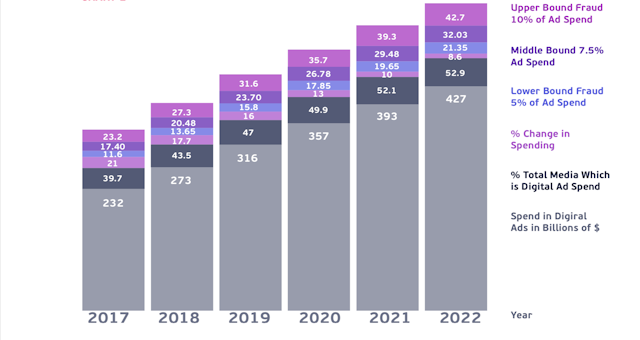Cost of global ad fraud could top $30bn
Global ad fraud is predicted to cost an unprecedented $23bn this year and could reach $30bn including indirect economic and social costs, according to the report ‘The Economic Cost of Bad Actors on the Internet, Ad Fraud 2019,” by cybersecurity company Cheq.

Cost of global ad fraud could reach $30bn, including indirect economic and social costs
Using economic analyses, proprietary data and expert interviews, Cheq compiled a report that reveals the extent of the damage caused to advertisers and consumers and investigates the root of the problem. Economist Roberto Cavazo, a professor at the University of Baltimore who worked in conjunction with Cheq, said in the report, “I have studied the economic costs of fraud in many sectors for decades, and I was left stunned by the scale of fraud in online advertising.”
Total market expenditures on online digital ads in 2019 is expected to rise to $316bn, Cheq reports. That number is greater than the entire GDP of Malaysia — and with so little regulatory oversight, the bloated advertising market looks as attractive as ever for fraudsters. The World Federation of Advertisers estimates that up to 30% of advertising is unseen by consumers, affecting about 21tn online ads annually. Anthony Hitchings, the Financial Times’ digital advertising operations director, said, “The scale of the fraud we found is jaw-dropping. The industry continues to waste marketing budgets on what is essentially organized crime.”
So why is this industry so rife with fraud? A lack of regulation is one reason, but another is much more inherent to advertising: complexity. Comparing financial services transactions with ad transactions is revealing. While US banks deal with five or six heavily regulated entities, in one ad transaction advertisers may deal with as many as 20 or more players whose interests are not aligned, Cheq says. Additionally, some banks may have $1m credit card fraud requests to investigate per day; in advertising, fraud prevention solutions face 20,000 requests every second.
Cheq predicts that the fraud is only going to get worse. The company expects the direct cost to advertisers to hit $26bn in 2020, $29bn in 2021, and $32bn in 2022. The worst part? This burden lands disproportionately on the shoulders of small firms that don’t have as much money as established brands to avoid ad fraud. “Our experience suggests that higher-end campaigns through well-known, reputable advertisers are subject to a 5% fraud rate,” the report says. “Lower-end campaigns experience a much higher rate of ad fraud, potentially up to 50%.”

Other studies, which pin the cost of ad fraud at about $7.2bn per year, fail to capture the full extent of the damage, according to Cheq. These studies often extrapolate from limited samples, analyzing only 27bn out of 70tn total annual ad impressions, for example. Such studies also restrict the scope of their research to botnets, which are just one source of ad fraud. “Where studies have shown that ad fraud is lower or even declining, we think this particularly unlikely,” the report states. “Digital ad marketing is growing at a high rate and thus is an attractor for increased fraudulent activity.”
Cheq’s research is different because it accounts for the indirect costs of ad fraud, not just the immediate financial loss for advertisers. Among the largest of these costs is a diminishment of trust between actors, which stifles innovation. Take it from Per Bjorke, a senior product manager who leads Google’s ad traffic quality team. “It’s very simple. The future growth of Google and other companies hinges on the fact that online advertising is trusted, and that there will be a return on investment on ad budgets,” he told CyberScoop, which Cheq then cited in the report. “It’s very important for us because people could stop investing in advertisements.”
This isn’t just conjecture. According to Cheq, when Proctor & Gamble reduced its digital ad spending by $200m, shifting that budget elsewhere, its subsequently increased its reach by 10%.

